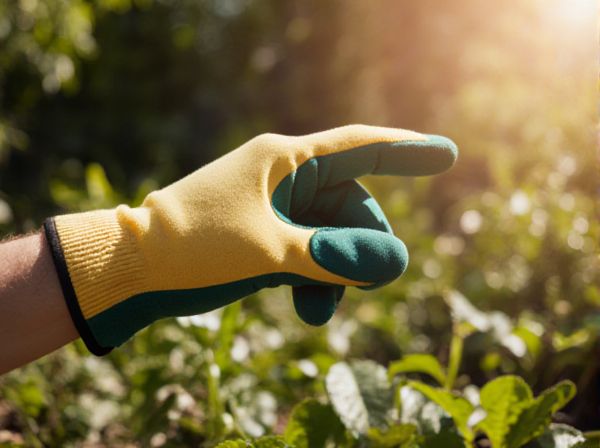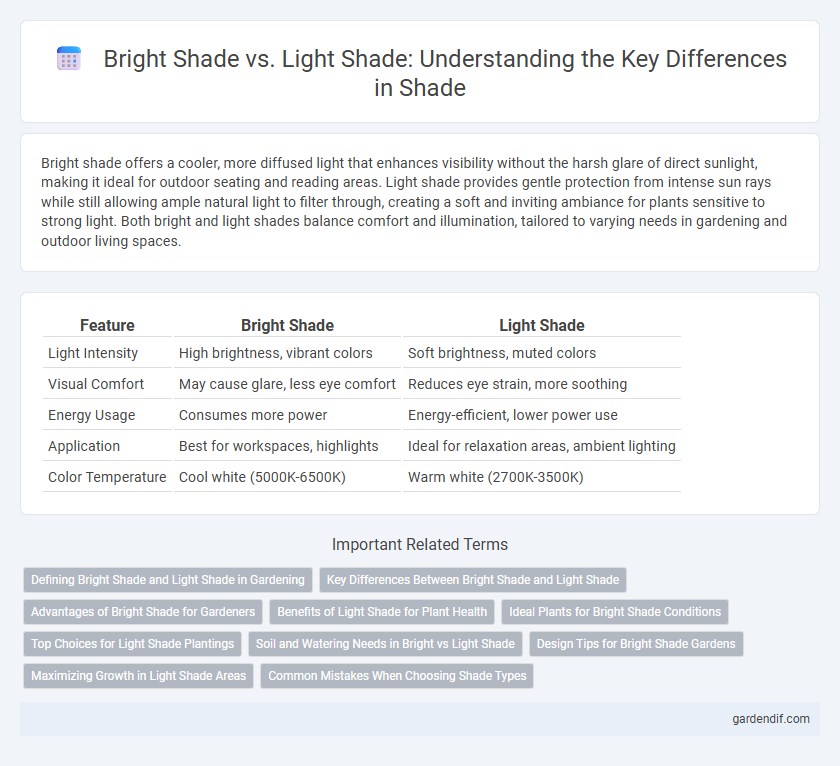
Bright Shade vs Light Shade Illustration
Bright shade offers a cooler, more diffused light that enhances visibility without the harsh glare of direct sunlight, making it ideal for outdoor seating and reading areas. Light shade provides gentle protection from intense sun rays while still allowing ample natural light to filter through, creating a soft and inviting ambiance for plants sensitive to strong light. Both bright and light shades balance comfort and illumination, tailored to varying needs in gardening and outdoor living spaces.
Table of Comparison
| Feature | Bright Shade | Light Shade |
|---|---|---|
| Light Intensity | High brightness, vibrant colors | Soft brightness, muted colors |
| Visual Comfort | May cause glare, less eye comfort | Reduces eye strain, more soothing |
| Energy Usage | Consumes more power | Energy-efficient, lower power use |
| Application | Best for workspaces, highlights | Ideal for relaxation areas, ambient lighting |
| Color Temperature | Cool white (5000K-6500K) | Warm white (2700K-3500K) |
Defining Bright Shade and Light Shade in Gardening
Bright shade in gardening refers to areas that receive filtered sunlight or indirect light for most of the day, ideal for plants needing moderate light without direct sun exposure. Light shade describes spots receiving a few hours of direct morning or late afternoon sun, combined with dappled shade during peak sunlight, suitable for plants tolerant of some sun but protected from intense midday rays. Understanding these distinctions helps gardeners choose appropriate plants that thrive under specific light conditions, optimizing growth and health.
Key Differences Between Bright Shade and Light Shade
Bright shade refers to areas that receive filtered sunlight with moderate intensity, creating a well-lit but cool environment ideal for plants like hydrangeas and hostas. Light shade, on the other hand, is characterized by fewer direct sun rays, resulting in a softer, dimmer setting suitable for shade-tolerant species such as ferns and impatiens. The key differences between bright shade and light shade lie in light intensity and duration, influencing plant growth, photosynthesis rates, and moisture retention in garden landscapes.
Advantages of Bright Shade for Gardeners
Bright shade provides an ideal balance of sunlight and protection, promoting healthy plant growth by preventing leaf scorch while ensuring sufficient light for photosynthesis. It supports a wider variety of garden plants, such as hostas and ferns, which thrive in these conditions compared to light shade that offers less illumination. Gardeners benefit from brighter shade as it enhances blooming and vigor, leading to lush, vibrant gardens with reduced water stress.
Benefits of Light Shade for Plant Health
Light shade provides plants with filtered sunlight that reduces the risk of leaf scorch while maintaining enough light intensity for photosynthesis, promoting healthier growth. This balanced exposure helps conserve soil moisture and prevents heat stress, creating an optimal microenvironment for root development and nutrient absorption. Compared to bright shade, light shade allows for improved chlorophyll production and stronger plant resilience against pests and diseases.
Ideal Plants for Bright Shade Conditions
Ideal plants for bright shade conditions include hostas, ferns, and astilbes, which thrive with indirect sunlight and moderate moisture. Bright shade offers filtered light from trees or structures, promoting lush foliage without the risk of leaf scorch typical in direct sun exposure. These plants adapt well to environments where sunlight is diffused, ensuring vibrant growth and prolonged flowering periods.
Top Choices for Light Shade Plantings
Bright shade offers filtered sunlight ideal for shade-loving plants like hostas and ferns, providing enough light without the intensity that causes leaf burn. Light shade, characterized by dappled or partial sunlight, suits plants such as begonias, impatiens, and caladiums, which require modest sun exposure to thrive. Top choices for light shade plantings include astilbes and coral bells, which balance aesthetics with adaptability to moderate light conditions.
Soil and Watering Needs in Bright vs Light Shade
Bright shade requires well-draining soil rich in organic matter to retain moisture without waterlogging, supporting plants that need consistent watering but not soggy conditions. Light shade allows for a broader soil type range but typically needs less frequent watering due to reduced evaporation rates and lower plant transpiration. Proper soil preparation and tailored watering schedules are essential to optimize plant health in both bright and light shade environments.
Design Tips for Bright Shade Gardens
Bright shade gardens thrive in areas receiving filtered sunlight or partial shade, creating vibrant yet sheltered environments ideal for many foliage plants. Use plants with variegated leaves or bold colors like hostas, caladiums, and ferns to maximize visual appeal and contrast in bright shade conditions. Incorporate reflective surfaces such as light-colored gravel or white garden furniture to amplify natural light and enhance the overall brightness of shaded garden spaces.
Maximizing Growth in Light Shade Areas
Maximizing growth in light shade areas requires selecting shade-tolerant plants that can thrive with filtered or indirect sunlight, such as hostas, ferns, and impatiens. Proper soil preparation and consistent moisture levels enhance root development and nutrient absorption, promoting healthier growth in these environments. Utilizing organic mulches helps regulate soil temperature and retains hydration, further supporting plant resilience and vitality in bright shade conditions.
Common Mistakes When Choosing Shade Types
Confusing bright shade with light shade often leads to improper plant placement, as bright shade refers to filtered sunlight with higher light intensity, while light shade offers gentler, indirect light. Many gardeners mistakenly place shade-loving plants in bright shade areas expecting minimal sunlight exposure, which can cause leaf burn and stress. Understanding the specific light requirements of plants and differentiating between bright shade and light shade ensures healthier growth and prevents common cultivation errors.
Bright Shade vs Light Shade Infographic

 gardendif.com
gardendif.com